|
|
|
Bottle Attributes Beer Bottle Closures
The closure used on a bottle can say something about a bottle's age. Regional preferences and traditions help to
dictate what closures were popular and for how long. Patented stoppers
can be no earlier than the submission and most were not used for very
many years.
There were a great number of patented closures for beer bottles, but few
were used and even fewer were successful. All of the closures shown
below were actually used on beer bottles. Those closure that were
used on more than 100 different beer bottles are in the first set by
earliest year of use or patent date:
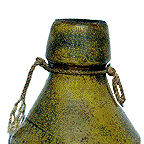 |
Cork, circ: pre-1600-1905,
By far the most common closure used on beer bottles until about 1880 when the Lightning
stopper became standard. Initially,
a string or wire was used to secure the cork to the bottle. Later, a wire
bail became the standard. Some bottlers still used corks into
the Twentieth Century, usually on export shaped bottles.
Corks for beer bottles were about one inch long. Example
shows string used to retain a cork in the bottle. |
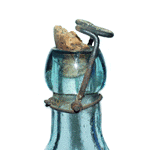 |
Putnam Closure, circ:
1859-1905,
Invented by: Henry William Putnam,
American Patent: March 15, 1859, Number: 23,263,
American Patent Reissued: January 19, 1864, Reissue Number: 1,606,
This cork fastener was the standard used on corked beer bottles
during the1860s and 1870s when it was replaced with the
Lightning stopper. The bail was reusable and the bottler was not
required to rewire the cork with every refilling of the bottle. |
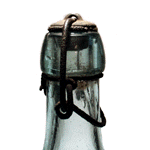 |
Lightning Closure, circ:
1875-1910,
Invented by: Charles De Quillfeldt,
American Patent: January 5, 1875, Number: 158,406,
American Patent Reissued: June 5, 1877, Reissue Number: 7,722,
This stopper revolutionized beer bottling and was an almost
instant success for Karl Hutter who acquired the patent rights
and popularized this stopper when it was reissued in 1877. In
1878, Henry Putnam also acquired and interest in this stopper
and in 1882 adapted it for use on fruit jars. There were many
imitators of this patent over the years, but they all worked on
the same principle of leveraging a rubber disk into the lip of
the bottle to make a seal. |
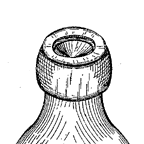 |
Bottle Seal or Baltimore
Loop Seal Closure, circ: 1885-1905,
Invented by: William Painter,
American Patent: September 29, 1885, Number: 327,099,
This stopper enjoyed moderate success, but was more popular in
some areas of than in others. It consisted of a disk, made
of a flexible material, that was inserted into a thin groove in
the lip of the bottle. It was replaced by Painter's
more popular crown cork stopper. |
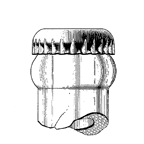 |
Crown Cork Seal Closure, circ: 1892-1920,
Invented by: William Painter,
American Patent: February 2, 1892, Number: 468,226,
This stopper did not enjoy immediate success. It consisted
of a metal cap that had a crimpled edge that when compressed
secured the cap to a specially designed lip. A cork liner
prevented contamination of the contents from the metal cap. By Prohibition, it was the standard as it was
easily adapted to automated bottling lines.
|
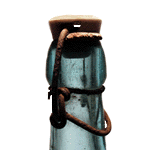 |
Hutter Closure, circ:
1893-1920,
Invented by: Karl Hutter,
American Patent: February 7, 1893, Number 491,113,
American Patent: June 16, 1896, Number 562,225,
American Patent: April 13, 1897, Number 580,456,
This stopper was an improvement to the Lightning stopper and was
extremely popular and eventually replaced the Lightning as the
preferred beer bottle stopper. A tapered porcelain plug was
fitted with a rubber washer on the bottom and forced into the
lip of the bottle to seal it. This stopper was replaced with the
crown cork. |
The following closures achieved moderate market success and were used
on between 5 and 100 different bottles:
 |
ABC Closure, circ: 1864-1867,
Occurs on 12 bottles,
 
Invented by: Edward Hamilton,
Improved by: Josiah Beard and Moses Fairbanks,
American Patent: January 5, 1864, Number 41,067,
American Patent: April 5, 1864, Number 42,188,
American Patent: December 6, 1864, Number 45,373,
American Patent: March 7, 1865, Number 46,658,
An early stopper that consisted of a hollow soft rubber ball
that was pulled into the neck of the bottle. The patent
was assigned to the Automatic Bottle Closing Company of New
Haven, Connecticut and all known bottles bear the "A. B. C. Co."
embossing. These bottles
are distinctive in shape and are also marked with the patent date.
A number of different bottlers experimented with this closure,
but none adopted it. |
 |
Kutscher 1869 Closure, circ:
1869-1890, Occurs on
13 bottles,
 
Invented by: Frederick Kutscher,
American Patent: June 15, 1869, Number: 91,349,
This closure was a basically flipped over the top of the bottle
and snapped on to the tie wire on the neck. This closure
was initially used on glass weiss beer bottles on the East
coast, close to its inventors home in New Haven, Connecticut.
However, it was used much later to about 1890 on pottery beer
bottles from Wisconsin. |
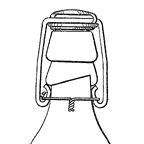 |
Matthews 1872 Closure, circ: 1872-1878, Occurs on
23 bottles,
 
Invented by: Joseph Connor,
Improvement by: John Matthews,
American Patent: June 11, 1872, Number: 127,851,
American Patent: January 25, 1876, Number: 172,757,
This was a form of cork fastener, with a modification by John
Matthews that used a rubber and metal stopper. These
were used on lager beer
bottles. It was used only in the metro New York and
Philadelphia areas. Bottles usually have the Matthews name
and the patent date embossed on the base and can be identified
by the unique bulge in the neck just below the lip. It was
replaced by the Lightning stopper. |
 |
Schlich Closure, circ: 1874-1885, Occurs on
15 bottle,
 
Invented by: Frederick Schlich,
American Patent: September 5, 1865, Number: 49,793,
American Patent: February 28, 1871, Number: 112,185,
American Patent: July 21, 1874, Number: 153,380,
This closure was perfected over nearly ten years by Frederick
Schlich of New York City. The stopper consisted of a
metal stopper with a rubber covering that was forced into the
mouth of the bottle. Although Schlich's patent preceded
the Lightning stopper by ten years, without a cam, it could
not compete and did not achieve market success. |
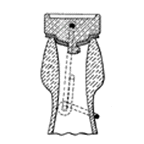 |
Fritzner 1880 Closure, circ:
1880-1920,
Occurs on 42 bottles,
 
Invented by: Nicolay Fritzner,
American Patent: July 13, 1880, Number: 229,815,
This closure was a variation of the Lightning closure with the
difference that the eccentric was mounted in a glass dimple in
the lip instead of on a mounting wire. The patent deals
with filling these bottles, but also identifies this new
configuration of the eccentric. This was used mainly on
pottery ginger beer bottles of later vintage. |
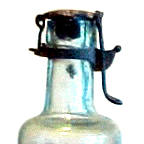 |
Rich Closure, circ: 1882-1885,
Occurs on
5 bottles,
 
Invented by: Augustus E. Rich,
American Patent: January 10, 1882, Number: 252,059,
This closure was marketed by the Champion Stopper Manufacturing
Company of Greenfield, Massachusetts. The stopper was
based on earlier patents and closed by tightened by pressing the
lever tight. |
 |
Rubin Closure, circ:
1884-1888, Occurs on
5 bottles,
 
Invented by: Max Rubin,
American Patent: April 29, 1884, Number: 297,952,
American Patent: May 27, 1884, Number: 299,269,
American Patent: November 11, 1884, Number: 307,990,
The patent was patented by Max Rubin of Philadelphia,
Pennsylvania. The stopper involved a cap that drawn down
onto the lip of the bottle by a twisting action. The
sole known intact stopper has both patent dates stamped, one on
each of the metal band that travels in the groove. The stopper is found on
several
bottles from the Northeast part of the country. |
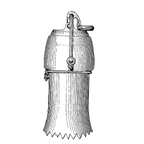 |
Argus Closure, circ:
1885-1895, Occurs on
8 bottles,
 
Invented by: Edwin Haas,
American Patent: March 10, 1885, Number: 313,588,
This closure was a variation of bailed closures. It
consists of a cam that when depressed forces the stopper into
the mouth of the bottle. The tab on the cam come in two
different configurations. This
stopper was only used on beer bottles. |
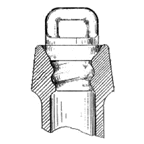 |
Riley Screw Closure, circ:
1885-1915, Occurs on
12 bottles,
 
Invented by: Frederic George Riley,
English Patent: July 7, 1885, Number: 8,198,
This closure was another English import that never became
successful. Riley improved the inside
screw stopper by adding a protrusion to the top of the stopper
that allowed for easier opening. |
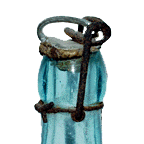 |
Lloyd Closure, circ:
1885-1895, Occurs on
13 bottle,
 
Invented by: Edwin L. Lloyd,
American Patent: August 25, 1885, Number: 325,181,
This closure was a variation of bailed closures. The
stopper was attached to the bail via a loop on it. This
stopper was only used on beer bottles. |
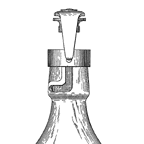 |
Fullerton Closure, circ:
1887-1890, Occurs on
5 bottles,
 
Invented by: George A. Fullerton,
American Patent: November 29, 1887, Number 373,973,
American Patent: October 2, 1888, Number 390,586,
Bottles that used this closure are identified by the unique "L"
shaped indentations on the lip of the bottle. The closure
consists of a sheet metal bail whose eccentric slid into the
groove in the lip. The patent was assigned to the Facile
Bottle Stopper Company of New York, New York, which is marked on
some of the bottles. The patent drawing shows a square
mark on the base of the bottle, which is present on some of the
known examples, but is not explained by the patent.. |
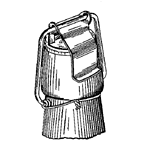 |
Bloeser Bail Closure, circ:
1888-1895, Occurs on
5 bottles,
 
Invented by: Rudolph Bloeser,
American Patent: March 6, 1888, Number: 379,149,
This stopper was consists of a wire bail with a stopper on it
that flips over the bottle's lip. The cam is a flat molded
piece of metal that forces the closure into the opening of the
bottle. This stopper was used by a few bottlers in the Scranton
area, where Bloeser was associated with a local glass house. |
 |
Aluminum Seal Closure, circ:
1895-1903, Occurs on
29 bottles,
 
Invented by: Robert Allison Hall,
American Patent: June 18, 1895, Number: 541,203,
This stopper was mainly used in the metro Baltimore area and was
a competitor to William Painter's Bottle Seal closure.
However, unlike the Bottle Seal there were two sizes as seen
on some of quart sized bottles. The groove on the inside
of the lip is very close to the top and is not as angular as
the Bottle Seal. Painter successfully sued Hall in 1903
and won. |
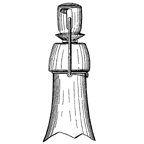 |
Landenberger Closure, circ:
1901-1905, Occurs on
6 bottles,
 
Invented by: Martin Landenberger,
American Patent: January 8, 1901, Number 665,689,
This closure is basically a lightning stopper, but what distinguishes
it is that the stopper itself is glass and not the typical
metal or porcelain. The stoppers are known in amber and
clear glass and in both cases the stopper matches the color of
the bottle. |
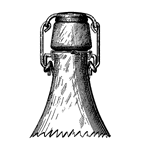 |
Thatcher 1901 Closure, circ:
1901-1910, Occurs on
34 bottles,
 
Invented by: Frederick B. Thatcher,
American Patent: October 15, 1901, Number 684,476,
This stopper was an improvement on the Lightning closure with a wire bail
and eccentric. The difference is that there were two
loops on the side of the stopper that accepted the eccentric.
One Boston bottler had his name impressed on the top of the closure.
The closure
appears to have had more success in the New England market as
Thatcher was from Providence Rhode Island. |
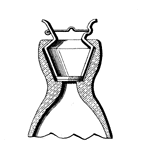 |
Universal Seal Closure, circ: 1901-1905, Occurs on
16 bottles,
 
Invented by: Edward D. Schmitt,
American Patent: October 22, 1901, Number: 685,226,
This stopper was only used in the metro Baltimore and
Philadelphia areas and was replaced by the crown cork seal
closure. Most of the bottles were used by the Gottlieb
Bauerschmidt Straus Brewing
Company of Baltimore. It appears to have been used
experimentally by the few bottles. Some of the
bottles are marked Universal Seal & Stopper Co. of Baltimore on the base and all have a
large tapered groove in the lip, which often flares out, with a
small ledge at its base. |
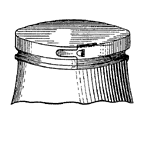 |
Phoenix Closure, circ:
1902-1910, Occurs on 63 bottle,
 
Invented by: Alfred L. Weissenthanner,
American Patent: July 22, 1902, Number
705,173,
This stopper of a metal cap that was secured to a specially
formed lip on the bottle, which is an exaggerated square
collar. This closure found some success at Midwestern
breweries. |
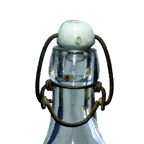 |
Strebel's Globe Closure, circ:
1903-1920,
Occurs on
13 bottles,
 
Invented by: Louis Strebel,
American Patent: April 14, 1903, Number 725,505,
This stopper was a slight deviation from the Hutter closure.
Instead of the inverted cone shaped porcelain stopper of
Hutter, this one has a rounded top. This was an
accommodation
for Strebel's bottling machine patented number 723,065 on
March 17, 1903. According to the patent, the stopper was
meant for carbonated beverages or for use on bottles that used
the Hutter stopper. The stopper was advertised as the
"Globe" and together with his bottling machine were
advertised as late as 1915. |
The following closures were used to seal beer bottles, but never achieved and level of success
or market penetration. They occur on from 1 to 5 bottles. Some were only used by the inventor.
 |
Cronk Closure, circ: 1858-1860, Occurs on 1 bottle,
 
Invented by: Munson C. Cronk,
American Patent: July 6, 1858, Number 20,778,
An early closure that was used to empty and reseal bottles.
It was described as a faucet that was controlled by a screw on
cap to empty the contents. Although described as a closure
for mineral water bottles, the only known bottle is a pottery
mead bottle. These bottles
are identical in shape to the standard mead bottles with a ledge
in the neck of the bottle, as reflected in the patent drawings. Munson Cronk, the inventor, was the
sole user. |
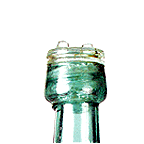 |
Whitney Inside Screw Closure, circ: 1861-1865, Occurs on 2 bottles,
 
Invented by: S. A. Whitney,
American Patent: January 1, 1861, Number: 31,046,
This closure consisted of a glass stopper that screwed into the
lip of the bottle, which had matching threads. The stopper
only occurs on one beer bottle, but enjoyed considerably more
success on whiskey bottles. |
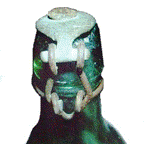 |
Castner Closure, circ:
1865-1870, Occurs on
1 bottle,
 
Invented by: Unknown,
American Patent: Unknown,
This closure a bail with a cast top. The stopper
only occurs on one Castner beer bottle from Changewater, NJ. |
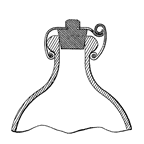 |
Morganstern Closure, circ:
1874-1879, Occurs on
1 bottle,
 
Invented by: William
Morganstern
American Patent:
September 3, 1872, Number: 131,111,
American Patent: August 25, 1874, Number: 154,410,
This patent
pressed metal clip closure. William Morganstern of New York City was
issued his first patent of this design in September of 1872 and
followed it up with improvements that manifested in
his August 1874 patent. This appears to be a take off of
Frederick Kutscher's 1869 patent. A rubber, cork or other
elastic material, which was attached to a plate was forces into
the mouth of the bottle and secured with a clip that swung into
place to fasten said plate and seal the bottle. |
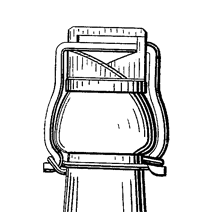 |
Trimble Closure, circ:
1874-1880, Occurs on
1 bottles,
 
Invented by: John B. Trimble,
American Patent:
December 1, 1874, Number:
157,431,
This patent was the first
of a few stoppers that used a "inclined plains on the plug to
force the stopper into the mouth of a bottle. John B. Trimble,
a Philadelphia merchant, came up with the idea, but it did not
catch on. Although it was used by a Providence, Rhode
Island Hotel owner and bottler. |
 |
Vom Hofe Closure, circ:
1875-1880, Occurs on
3 bottles,
 
Invented by: William Vom Hofe,
American Patent: May 18, 1875, Number: 163,553,
American Patent: August 24, 1875, Number: 167,141,
This patent was the first in a long series of levered or pump
handled stoppers. William Vom Hofe of New York City was
issued his first patent of this design in May of 1875 and
quickly followed it up with improvements that manifested in
his August 1875 patent. It is unlikely many of the
earlier patent design made it past the prototype stage. There
were a number of very similar pump handled patents of similar
style that were patented over the next twenty-five years and
caution should be used before attributing this patent to a
specific closure. |
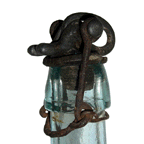 |
Bate's Closure, circ:
1875-1880, Occurs on
2 bottles,
 
Invented by: Wallace H. Bate,
American Patent: September 14, 1875, Number: 167,633,
This patent was awarded to Wallace H. Bate of Norwood, Massachusetts. The
approach was to use a cam lever, secured under the lip by a
wire, that would force the rubber lined stopper into the mouth
of the bottle. This would have been an early competitor
to the Lightning stopper, patented a mere 8 months prior.
Part of the rights to this patent were assigned to Mathias
Radermacher of Boston, who appears to be the sole user of this
stopper. |
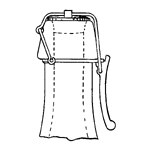 |
Whitman Closure, circ:
1878-1880, Occurs on
3 bottles,
 
Invented by: William G. Whitman,
American Patent: April 9, 1878, Number: 202,320,
This patent was applied for nearly a year before it was issue
to William Whitman of Chicago, Illinois. The stopper consisted of a
metal stopper with a rubber covering that was forced into the
mouth of the bottle by a lever that resembles a pump handle.
Part of the rights to this patent were assigned to John A.
Lomax, the major bottler in Chicago, and a Martin I. Whitman,
also of the same place. This stopper never met with much
success, but should be found on other Upper Midwestern
bottles. |
 |
Smith Closure, circ:
1878-1880, Occurs on
2 bottles,
 
Invented by: Thomas S. Smith,
American Patent:
December 3, 1878, Number:
210,438,
This patent was
one of many issued in the second half of the 1870s that were
based on some sort of cam lever that would pressure the stopper
into the mouth of the bottle. These were to compete with
the Lightning Stopper, patented in 1875and dominating the
marketplace. This stopper is only known on one one bottle
used by G. W. & C. R. Miller of Boston. Graci attributes
this stopper to the James T. Walker of Troy, NY and his April
14, 1885 patent number 315,576. The Millers were listed in
the 1876 thru 1885 Boston Directories. Since the business
ended the same year of Walker's patent and the patent drawings
of Smith's stopper more closely match the Miller bottle. I
am attributing it to the ealier patent. Needless to say this
patent did not meet with much success. |
 |
Magic Closure, circ:
1878-1880, Occurs on
2 bottle,
 
Invented by: Henry W. Putnam,
American Patent: May 31, 1878, Number: 212,623,
This patents was issued to Henry W. Putnam of Bennington,
Vermont and appears to have some success.
This patent was quickly improved upon by to a later patent in
1880. The stopper consisted of a
removable metal stopper with a rubber covering that was forced into the
mouth of the bottle using the typical wire bail. The
stopper was to be used in conjunction with a bottling machine
that forced the detached stopper into the mouth of the bottle
after it was filed with the beverage. The stopper was hampered by the
fact the the stopper could easily be lost as it was not secured.
The later improvement added a clip to solve this problem. |
 |
Improved Magic Closure, circ:
1880-1890, Occurs on
2 bottle,
 
Invented by: Henry W. Putnam,
American Patent: February 10, 1880, Number: 224,304,
This patent was an improvement to earlier patents issues to
Henry W. Putnam of Bennington, Vermont and appears to have
seen some commercial use. The stopper consisted of a
removable metal stopper with a rubber covering that was forced into the
mouth of the bottle using the typical wire bail. The
stopper was to be used in conjunction with a bottling machine
that forced the detached stopper into the mouth of the bottle
after it was filed with the beverage. The stopper was then
secured by snapping the bail in place. This stopper met with
some level of success, but was hampered by the need to invest in a bottling machine in
addition to a supply of stoppers, but solved the problem of
the earlier stopper. |
 |
Hammer Closure, circ: 1883-1900, Occurs on
1 bottle,
 
Invented by:
Charles Otto Hammer,
American Patent: December 20, 1881, Number: 251,223,
American Patent: December 18, 1883, Number: 290,577,
This closure is a variation, in principle, of the
Lightning stopper. This closure can be identified by its
large rectangular openings on the plug where the eccentrics
attached. The
only known application was on a beer bottle used by John A.
Darlington of Brooklyn, New York and this was well over a decade
after patented. The later Thatcher 1901 patent may have
been based on this design. This was previously known as the Darlington
and Gross closure. |
 |
Lloyd 1883 Closure, circ:
1883-1885, Occurs on
1 bottle,
 
Invented by: Edwin L. Lloyd,
American Patent: June 19, 1883, Number: 279,777,
American Patent: June 26, 1883, Number: 280,196,
This closure was a variation of
Putnam cork fastener and the lightning stopper. The
rubber plunger on a metal disk with a nob on top was fastened to
the Putnam like bail by a wire loop. Half of the patent was
assigned to the beer bottler Charles Joly of Philadelphia.
It was marketed by the Lloyd Stopper Company. It was
replace by later Lloyd inventions. |
 |
Burns Bail Closure, circ:
1884-1885, Occurs on 1 bottle,
 
Invented by: Frank Burns,
American Patent: November 27, 1883, Number: 289,215,
American Patent: June 24, 1884, Number: 300,945,
This closure was a variation of
Lightning stopper. The
rubber plunger on a metal disk was reversible and attached to a
W-shaped lever that was anchored in indentations in the lip.
It was marketed by the Burns Manufacturing Company Limited of
North East, Pennsylvania. It does not appear to have been
adapted by the industry. |
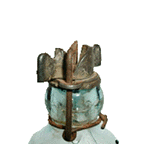 |
Lowell Closure, circ: 1885-1890, Occurs on 1 bottle,
 
Invented by: George D. Corey,
American Patent: February 10, 1885, Number: 312,096,
The patent for this closure was assigned to Woods, Sherwood & Company of
Lowell, Massachusetts. The stopper was based on the
Lightning closure with a stopper that tightened to the bottle as
it was twisted. The stopper is found on on a bottle marked
"The Lowell Bottle Stopper." |
 |
Bernardin Closure, circ:
1885-1920, Occurs on
2 bottles,
 
Invented by: Alfred L. Bernardin,
American Patent: March 24, 1885, Number
314,358,
This closure was only
found on soda and beer bottles intended for reuse and was mainly
used as a cheap cork fastener on wine and liquor bottles that
were not intended to be returned. The current example was
on a sample bottle given away at a jubilee in Chicago. Since the
stopper needed to be removed and there was no way to reattach it
as it was destroyed in the process, it is normally only found on
bottles that were never opened. |
 |
Wizard Closure, circ:
1885-1890, Occurs on
3 bottles,
 
Invented by: William Painter,
American Patent: April 14, 1885, Number: 315,655,
This closure was a variation of bailed closures. This was
William Painter's first bottle closure patent. He would
be much more successful on his later Bottle Seal and Crown
Cork closures. This
stopper was only used on beer bottles. |
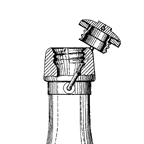 |
Kent Closure, circ: 1885-1890, Occurs on
4 bottles,
 
Invented by: Alonzo F. Kent,
American Patent: April 14, 1885, Number 315,797,
This closure was only used by several bottles of beer.
The bottles can be identified by the the tight threads that
received a metal stoppers that screwed into the lip. The
stopper was secured to the bottle by a loose fitting bail that
was fitted to the neck. |
 |
White Closure, circ: 1886-1888, Occurs on
1 bottle,
 
Invented by: Frank C. White,
American Patent: March 9, 1886, Number
337,541,
This closure was only used by New Jersey beer bottler.
The bottles can be identified by two glass lugs on the neck that
held a metal bands and the lack of any definable lip. The
stopper was secured to the bottle by a loose fitting bail that
was fitted to the neck. |
 |
Keystone Lever, circ:
1886-1890, Occurs on
1 bottle,
 
Marketed by: Keystone Bottle Stopper Company,
American Patent: Based on Vom Hofe's 1875 Patents,
This closure occurs on one bottle from Northwestern
Pennsylvania. It was based on Vom Hofe's 1875 patents
and was marketed by the Keystone Stopper Company of
Pittsburgh, PA. The pump-like lever of the 1875 patent
was replaced by a smaller triangular thumb lever.
Keystone was sued by Henry Putnum in 1889 for infringement on
the lightning stopper patents awarded Charles De Quillfeldt in
1875 and reissued in 1877. Putnam proved Vom Hofe's patents
were an infringement on the tenants of the Charles De
Quillfeldt patents. Keystone lost the case and was dissolved
in 1890. |
 |
Closure,
circ: 1889-1895Joly , Occurs on
1 bottle,
 
Invented by: George, John George, and Martin Rehfuss,
American Patent: April 30, 1889, Number: 402,350,
American Patent: June 4, 1889, Number: 404,797,
This patent was assigned to the Joly Stopper Company, which was
a spin off business of Charles Joly and his bottling business.
This stopper consists of a rubber washer secured by a metal
"stud" creating a plug that was secured by a "bail", which was
connected to a lever with a "C" shaped extension that would
press up on the bottom of the bottle's lip and exert pressure on
the plug, which held in the liquids. This stopper was used by
one Philadelphia bottler, but should be present on period Joly beer bottles. |
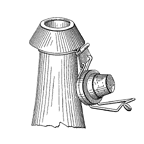 |
Howe Closure, circ: 1889-1890, Occurs on
3 bottles,
 
Invented by: Thomas B. Howe,
American Patent: June 11, 1889, Number: 405,035,
This stopper was consists of a wire bail with a stopper on it
that flips over the bottle's lip and a clip secures the stopper
by snapping under the lip. The lips on these bottles are
oversized tapers that have a unique shape to support the
closure. This stopper was used by two Philadelphia
bottlers. |
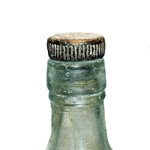 |
American Screw Closure, circ:
1890-92, Occurs on
2 bottles,


Invented by: Henry Barrett,
American Patent: August 3, 1880, Number: 230,605,
Another English import, this stopper was never popular in the
United States, however it was widely accepted in England and its
colonies. A composite stopper was screwed into the lip of the
bottle, which had screw threads on the inside. The stopper
was marketed by the American Screw Stopper Company, Limited,
in Jersey City, which only advertised in 1891and only appears
to have been used by firms in Northern New Jersey. |
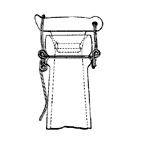 |
Siemens Closure, circ:
1891-1920, Occurs on
1 bottle,
 
Invented by: Frederick Siemens,
German Patent Issued: November 27, 1891, Number: 59,915,
This stopper was consists of a wire bail with a rubber capped porcelain
stopper on it
that flips over the bottle's lip. A loop engaged one end
of the stopper and drew the stopper against the lip as its cam
lever was tightened. This was an improvement on Siemens'
earlier patent 58, 602. The lips on these bottles are of a
double rounded collar design with the fastening wire in the
groove between the two. Although popular in Europe, this
closure had very limited use in North America. |
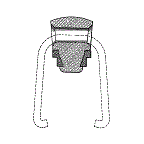 |
Dreyfuss Closure, circ:
1895-1910, Occurs on
3 bottles,
 
Invented by: Bernard Dreyfuss,
American Patent:
October 15, 1895, Number: 547,878,
This closure is a variation of the Hutter porcelain stopper,
which was patented in 1893. Dreyfuss claimed that the
arrangement of the stopper head significantly reduced the wear
on the rubber gasket that sealed the bottle. The stopper
was marketed by the Dreyfuss Bottle & Stopper Company of New
York City; Dreyfuss' home. A sample or marketing model
exists for this patented closure. |
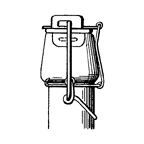 |
Manning Closure, circ:
1896-1900, Occurs on
1 bottle,
 
Invented by: Elwin W. Manning,
American Patent: May 26, 1896, Number: 561,013,
This closure is a variation of the lightning stopper.
Manning claimed his stopper was of an "improved
character." Manning was a bottler in Waverly, New
York and used the stopper on his bottles. Due to the
more complex nature of the stopper, and with no clear
advantages. It is doubtful any other bottlers adopted
Manning's stopper. |
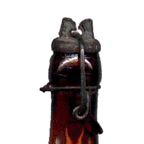 |
Cunningham Closure, circ:
1897-1910, Occurs on
4 bottles,
 
Invented by: William J. Cunningham,
American Patent: May 25, 1897, Number: 583,211,
This closure is a variation of the lightning stopper. The
purported advantage was the fact that the stopper would open
more freely than the typical Lightning closure. Cunningham
was a member of the Cunningham Supply Company, which supplied
bottlers. |
 |
De Quilllfeldt 1897 Closure, circ:
1897-1905, Occurs on
1 bottle,
 
Invented by: Charles De Quillfeldt,
American Patent: August 10, 1897, Number 588,009,
This stopper was a supposed improvement to the Hutter stopper
and was likely invented to capitalize on its popularity.
Like the Hutter stopper, a tapered porcelain plug was fitted
with a rubber washer on the bottom and forced into the lip of
the bottle to seal it. The improvement was that the
opening for the bail in the porcelain was slot shaped instead of
triangular and the cross member of the bail was bent downward to
provide the leverage to seal the bottle. The stopper is
marked on the base "DE Q" and likely sold by the De Q Bottle
Stopper Company, who Hutter sued in 1904 for a patent
infringement. |
 |
De Witt Closure, circ: 1897-1910, Occurs on
1 bottle,
 
Invented by: Charles De Witt,
American Patent:
September 7, 1897, Number 589,704,
This stopper was a supposed improvement to the Hutter stopper
and was likely invented to capitalize on its popularity. Like
the Hutter stopper, a tapered porcelain plug was fitted with a
rubber washer on the bottom and forced into the lip of the
bottle to seal it. The improvement was that the opening was
a narrow slot
centered in the porcelain stopper that prevented the stopper
from being closed on an angle, which could cause the
stopper to break or not seal the bottle correctly. Likely
sold by Charles De Witt & Company, who were bottle dealers.
The actual closure has a diamond shaped instead of a slot based
opening. |
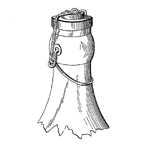 |
Alston Closure, circ: 1900-1905, Occurs on
3 bottles,
 
Invented by: John S. Alston,
American Patent: April 3, 1900, Number 646,653,
American Patent: December 31, 1901, Number 690,220,
This stopper was consists of a wire bail with an eccentric that
inserts into the lip. Only a Camden and Philadelphia bottler
appears to have adopted this closure. With the third bottle being a salesman's sample. The lips on these
bottles are exaggerated to accept the closure. The closure
appears to have had more success on fruit jars with the Alston
label. |
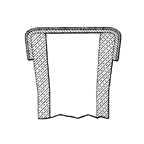 |
Imperial Bottle Closure, circ:
1902-1903, Occurs on
2 bottles,
 
Invented by: Nathaniel B. Abbott,
American Patent: July 8, 1902, Number 704,167,
This stopper of a metal cap that was secured to a flared lip on the
bottle. This was a deviation of William Painter's Crown
Cork. Painter sued Abbott in 1903 and won.
Although this stopper occurs on two bottles, it may not have
been commercially produced. |
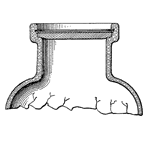 |
Inter-Seal Bottle Closure, circ:
1903-1906, Occurs on
2 bottle,
 
Invented by: William S. Dorman,
American Patent: October 6, 1903, Number 740,631,
This stopper consisted of a metallic disk that was attached to
an elastic sealing material. The disk locked into grooves in
side the lip of the bottle or jar. This was a deviation of William Painter's
loop seal. A firm called the Inter-Seal Company was
organized to market this closure in 1904, but is was defunct
by 1906 .
Although this stopper occurs on a sample bottle, it may not have
been commercially produced. |
 |
Kork-N-Seal Closure, circ:
1911-1945,
Occurs on 1 bottle,
 
Invented by: George Albert William,
American Patent: June 5, 1906, Number 822,567,
When he cut his hand while trying to open an ginger ale
bottle, George Williams vowed to invent a better
closure. He got his idea in 1901 and continued to refine
it as a pass time. He patented it in 1906, organized the
Williams Sealing Corp. on October 19, 1909, refined the
machinery to make the closure, and sold them commercially
starting in 1911. An initial reseller was the Illinois
Glass Company in 1911 as illustrated in their catalogue of
that year. The initial factory was located
in Waterbury, CN, but a factory was later opened in Decatur.
IL, to be closer to the customers. The closure became
popular as a resealing device on crown top beer and soda bottles and was being
used during the Second World War. It was used as a
primary closure on medicine and cosmetic bottles. |
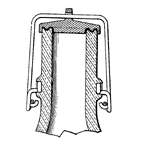 |
Sani-Top Closure, circ:
1908-1912,
Occurs on 1 bottle,
 
Invented by: Anthony F. McDonnell,
American Patent: July 14, 1908, Number 893,008,
The inventor claimed that his new closure did not cause
distortions in the neck of the bottle and better facilitated
cleaning and filling. McDonnell claims to be a
"practical bottler and glass manufacturer" and owned
the Scranton Glass Company of
Scranton, PA; a glass jobber. In 1910, McDonnell trade
marked his closure "Santitop." |
| Want more information? Get a book: |
 |
Soda and Beer Bottle Closures 1850-1910 David Graci 2003 This book covers the subject of mainly American soda and beer bottle closures that were used by bottlers and brewers. A decade by decade history is provided as well as numerous illustrations and pictures. |
$24.95

|
|
|

